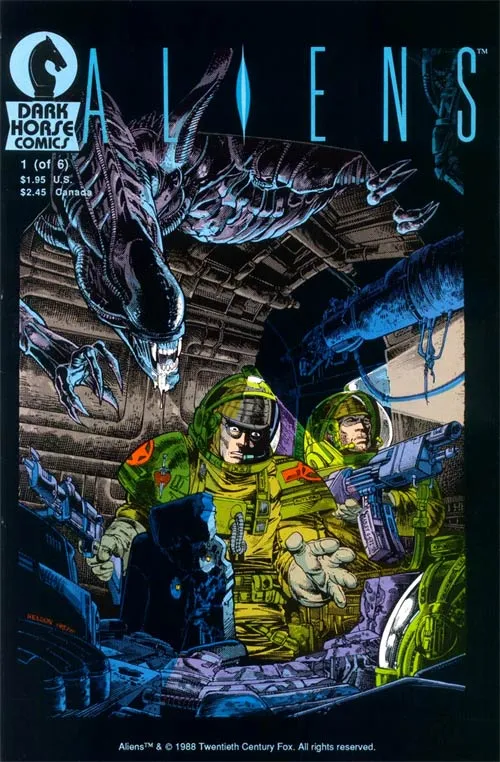
What If There Was No Alien 3?

Obviously that isn't what Dark Horse Comics was asking with the release of Aliens #1 (later known as Aliens: Book One), since this book arrived on shelves four years before Alien 3 hit local cinemas. In fact, as far as anybody at the time knew, there weren't any plans for a third film. Even if there were, it wasn't likely to show up any time soon -- it was seven years between Ridley Scott's horror film and James Cameron's action epic, after all, and (in theory) that gave plenty of time and plenty of room to keep the story going.
Dark Horse operated a different publishing strategy from the "Big Two" of the era. Rather than trying to compete on long-running serials and unlimited series with recurring characters the way Marvel and DC had built their brands, Dark Horse focused on the smaller scale in areas where there wasn't much competition. They published books by indie writers and artists who were interested in telling stories not related to the exploits of caped crusaders and strange visitors from other planets. They often printed issues in black-and-white, both to keep costs lower and to highlight the importance of the ink-work, giving their comics a sort of Twilight Zone-esque feeling as a side-bonus. They dabbled in translating and publishing works from non-American, non-English-language writers, especially from France, eastern Europe, and Japan. Most importantly, they didn't submit their books to the Comics Code Authority, meaning they were at liberty to take more risks and tell more mature stories than the other guys on the shelf. These high-risk, low-yield ventures were made possible by tapping into a rich vein of licensed territory to make their bread and butter: comics set in well-known, popular cinematic universes, generally with a science fiction or horror setting, and not meant for children.
Comic adaptations of film, television, and other pop culture were nothing new even to the bigger studios. Marvel held the monopoly on Star Wars and Indiana Jones comics for quite some time, and published plenty of books aimed at children who played with Transformers, G.I. Joes, and other popular toys. They also periodically held the rights to books based on family-unfriendly universes like Robocop and Terminator 2, but used them to produce kid-tested and mom-approved stories in these R-rated worlds. Dark Horse, however, wasn't interested in writing comic books for the all-ages crowd. They didn't want to have to tone down the violence, the horror, and the dread inherent in these properties, they wanted to tell stories by adults for adults.
They also wanted to tell complete stories. Dark Horse wasn't interested in sprawling epics that ran hundreds of issues with no resolution in sight. They wanted an arc that could be finished in six months to a year, so potential buyers knew they wouldn't be strung along for two decades' worth of filler and an ever-changing roster of writers, co-writers, editors, artists, and quality. They got their claws into the Aliens universe with this book in May of 1988. So, back to that question:
"What if there was no Alien 3?"
Then there would be only Aliens: Book One, and I'm not gonna lie: much as I love the much-maligned third film of the franchise, I'd be fine with a world where Dark Horse's sequels were canon. Producing non-canonical work is fraught with its own peril though. Much as Alan Dean Foster found out when much of The Empire Strikes Back went on to contradict Splinter of the Mind's Eye, it doesn't take much for the next movie to take a massive bite out of your story, especially when your main characters are these two:
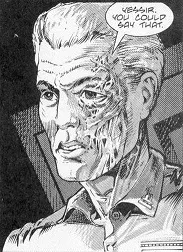
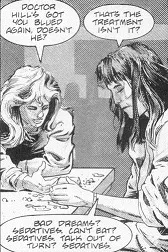
OK, so you could be forgiven for not recognizing them right away. Dark Horse only got the rights to the universe and the characters, not the actors' likenesses, but that's none other than Corporal Hicks and Rebecca "Newt" Jordan. (Newt's the one on the right in that panel, by the way, complaining about the sedatives). We learn Ripley's alive as well a little later, but writer Mark Verheiden made the decision not to involve Ripley as a main character, and it's incredible to me as a reader both that Dark Horse went along with this line of thinking and that it actually works as well as it does.
Aliens: Book One opens years after the disaster on Acheron, where Ripley, Hicks, and Newt were the only survivors. Having escaped the destruction of the colony and the Queen Alien's subsequent shipboard rampage, the trio made their way back to Earth where they've since separated.
Hicks is still in the Colonial Marines, though he's considered an outcast even within his own unit. Anger management issues since his return have resulted in increasingly lengthier stays in the brig, mostly on drunk & disorderly charges, but the Corps won't just discharge him and be done with it. He suspects it's because he's the only Marine to come into contact with the xenomorphs and live, and the brass keeps him around just in case they need his experience.
Newt, likewise, isn't taking to re-integration very well. Growing into a young woman, she suffers from psychological trauma and recurring nightmares (think 'mental institute Sarah Connor' in Terminator 2), both of which have landed her in psychiatric care, reciting her dreams to shrinks and trying to figure out what to do with her life.
And Ripley? Sorry, that's classified.
In any case, the story begins with Newt relating her latest nightmare to her doctor while strapped down to her bed:
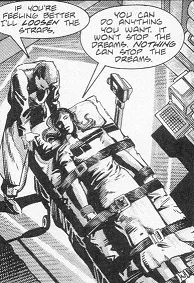
Then shifts to Hicks in a detention cell, plagued by similar nightmares, before he's awoken to the news he's earned early release (much to his annoyance but his cell-mate's relief). Ordered to watch a proffered videodisc then report to the Colonel once he's done so, Hicks gets himself presentable and settles down to watch what resulted in his early release.
The video is footage taken from the Dutton, a Coast Guard salvage ship which examines discarded space hulks and primes them for destruction before they can burn up in the atmosphere and make land-fall. The Dutton sends over a probe ship to investigate a derelict where someone on board apparently went mad and slaughtered the rest of the crew:

Given this is an Aliens book, you've probably already figured out what happened: one of our unfriendly neighborhood xenomorphs got aboard and wrecked a little havoc of its own. It manages to hitch a ride on the probe ship, which takes it back to the Dutton with predictable results:
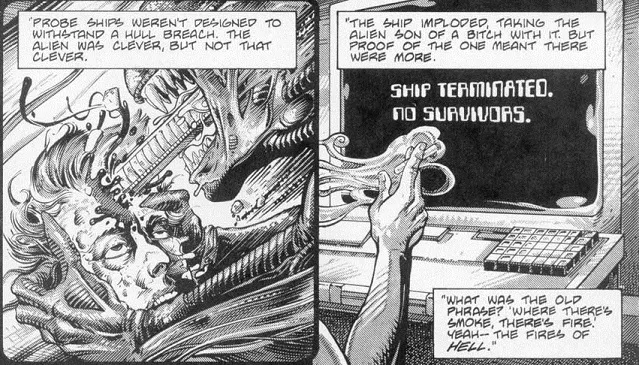
Well, that's evidence enough for the Corps to act and to haul Hicks out of detention. Where there's smoke, there's fire, he reminds us. Before the Dutton went kablooey, they transmitted a backup of the data banks they recovered from the derelict, and the USCMC has a detailed flight log of every landing the ship made before it wound up in Earth's orbit pending destruction. But, unfortuately for Hicks, the man in charge of the operations is a geneticist. He's not interested in wiping out the xenos...he wants a live specimen, and he's not beneath sending Hicks back into the meat grinder to procure his samples.
Somewhere else in space, a futuristic televangelist is setting up shop. Armed with an antique portable video camera and what appears to be a holo projector of some kind, he's about to give the masses some of that old-time religion with a decidedly new-age twist:
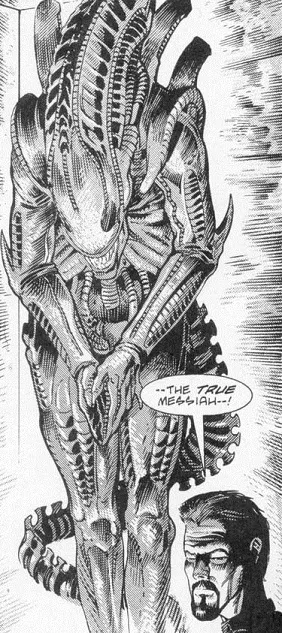
I'm not gonna lie, I think artist Mark Nelson does a fantastic job bringing the Aliens universe to life with his pen-and-ink drawings. The casual way he depicts horrible stuff happening to innocent people is well-executed, and it wasn't until I went back for this re-read that I caught the way Hicks' acid-burned countenance is always turned away from the viewer or hidden in shadows until the reveal. It's done very subtly too, everything looks natural up until that point, so it's a bit of a shock and a reminder that, yeah, Hicks took quite the beating in his first encounter with the creatures. Nelson's depiction of the aliens is spot-on as well, with a lovely full-page burst when the creature makes its presence known to the crew of the Dutton being one of the stand-out moments.
What I also think is interesting about Aliens: Book One is the way Verheiden's script manages to almost be Dead Space twenty years before there would be a Dead Space, what with a religious cult driving people to awful behavior surrounding an alien species that destroys everything it comes into contact with. It's a little weak that Hicks seems to be playing out Ripley's story arc in a way, with the "we need you there as an adviser because you've seen these things before" spiel he's handed, but not wholly unexpected. I mean, it is a logical continuation from where the James Cameron film left off. Newt also doesn't get a lot of play in this one, and the stuff she does get is very "Sarah Connor from T2"-esque, but I had to keep reminding myself this comic pre-dates Terminator 2: Judgement Day by three years, so if there was any ripping-off being done, it was the other way around.
The full issue is twenty-one total pages of story, but it's plenty enough to get one excited for the next issue's release, which would be two months later in July of 1988.
It's awesome to go back and look at these early spin-offs and adaptations, and if this gets a decent amount of traction, I'll probably run through the other five books in this arc, or examine one of the others, like Colonial Marines or Aliens vs. Predator. If you have suggestions you'd like to see, by all means, sound off in the comments!
Also, early fans of this series should not fret: I have not forgotten my promise to continue my slog through Atomik ANGELs. I just couldn't possibly subject my readers or myself to more 90's comic madness without taking some time off to examine something more palatable. You understand, right?
Right...?